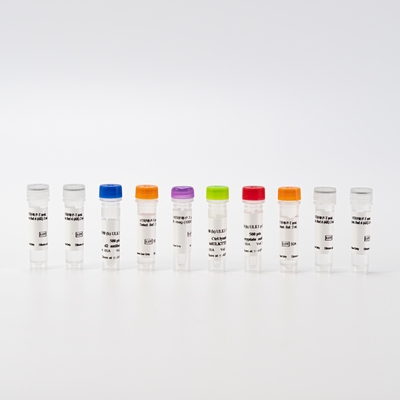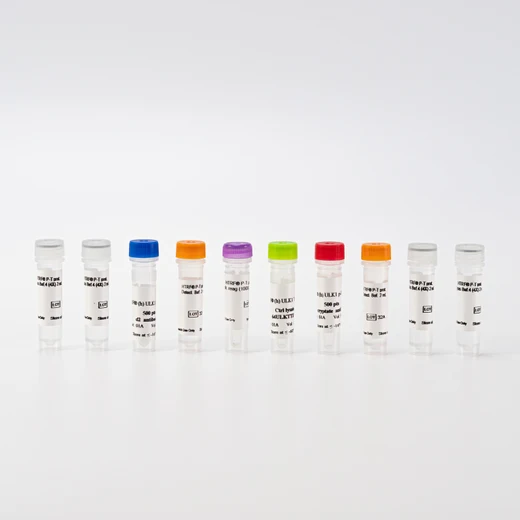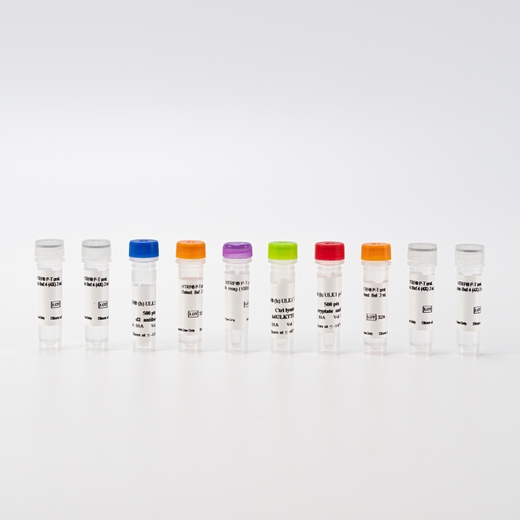

HTRF Human Total ULK1 Detection Kit, 10,000 Assay Points


HTRF Human Total ULK1 Detection Kit, 10,000 Assay Points






This cell-based HTRF kit enables the quantitative detection of Total ULK1 in human cell lysates.
For research use only. Not for use in diagnostic procedures. All products to be used in accordance with applicable laws and regulations including without limitation, consumption and disposal requirements under European REACH regulations (EC 1907/2006).
| Feature | Specification |
|---|---|
| Application | Cell Signaling |
| Sample Volume | 16 µL |
This cell-based HTRF kit enables the quantitative detection of Total ULK1 in human cell lysates.
For research use only. Not for use in diagnostic procedures. All products to be used in accordance with applicable laws and regulations including without limitation, consumption and disposal requirements under European REACH regulations (EC 1907/2006).



HTRF Human Total ULK1 Detection Kit, 10,000 Assay Points



HTRF Human Total ULK1 Detection Kit, 10,000 Assay Points



Product information
Overview
ULK1 is a cytoplasmic kinase part of a complex which acts as an upstream regulator of macroautophagy promoting phagophore formation. Autophagy is a physiological process maintaining cellular homeostasis. It makes ULK1 a new therapeutic target for various disorders (ageing related diseases, infectious disease, lysosomal storage disorders, neurodegenerative diseases, or cancers).
Specifications
| Application |
Cell Signaling
|
|---|---|
| Brand |
HTRF
|
| Detection Modality |
HTRF
|
| Lysis Buffer Compatibility |
Lysis Buffer 1
Lysis Buffer 2
Lysis Buffer 3
Lysis Buffer 4
|
| Molecular Modification |
Total
|
| Product Group |
Kit
|
| Sample Volume |
16 µL
|
| Shipping Conditions |
Shipped in Dry Ice
|
| Target Class |
Phosphoproteins
|
| Target Species |
Human
|
| Technology |
TR-FRET
|
| Unit Size |
10,000 Assay Points
|
Video gallery

HTRF Human Total ULK1 Detection Kit, 10,000 Assay Points

HTRF Human Total ULK1 Detection Kit, 10,000 Assay Points

How it works
HTRF Human Total ULK1 assay principle
The HTRF Human Total ULK1 assay quantifies the expression level of ULK1 in a cell lysate. Unlike Western Blot, the assay is entirely plate-based and does not require gels, electrophoresis, or transfer. The Human Total ULK1 assay uses two labeled antibodies, one coupled to a donor fluorophore and the other to an acceptor. Both antibodies are highly specific for a distinct epitope on the protein. In presence of ULK1 in a cell extract, the addition of these conjugates brings the donor fluorophore into close proximity with the acceptor, and thereby generates a FRET signal. Its intensity is directly proportional to the concentration of the protein present in the sample, and provides a means of assessing the protein’s expression under a no-wash assay format.

Human Total ULK1 two-plate assay protocol
The two-plate protocol involves culturing cells in a 96-well plate before lysis, then transferring lysates into a 384-well low volume detection plate before the addition of Human Total ULK1 HTRF detection reagents. This protocol enables the cells' viability and confluence to be monitored.

Human Total ULK1 one-plate assay protocol
Detection of Human ULK1 with HTRF reagents can be performed in a single plate used for culturing, stimulation, and lysis. No washing steps are required. This HTS designed protocol enables miniaturization while maintaining robust HTRF quality.

Assay validation
Inhibition of ULK1 Ser556 phosphorylation using AMPK inhibitor on different cell lines
U-87 MG or MCF7 cells were plated in a 96-well culture-treated plate under 100,000 cells per well in complete culture medium, and incubated overnight at 37°C, 5% CO2.The cells were then treated with increasing concentrations of AMPK inhibitor (BAY-3827) for 1H at 37°C, 5% CO2. After cell lysis with 25 µL of supplemented lysis buffer #4, 16 µL of lysate were transferred into a 384-well low volume white microplate before the addition of 4 µL of the HTRF Total ULK1 detection antibodies. The HTRF signal was recorded after an overnight incubation.
As expected, our results show a dose-dependent decrease in phosphorylated ULK1 on Ser556 upon AMPK inhibitor treatment, while the Total ULK1 expression level is not significantly modulated. In addition, no cytotoxic effects were observed with GAPDH Housekeeping Cellular Kit (Revvity®, Ref. 64GAPDHPEG) in the same experimental conditions (data not shown).


Specificity of Total ULK1 assay
Total ULK1 expression levels were assessed with the HTRF Total ULK1 kit in different HAP1 cell lines.
HAP1 Wild Type (HAP1 WT) and HAP1 knocked out for ULK1 (HAP1 KO ULK1) cell lines were cultured in T175 flasks in complete medium at 37°C, 5% CO2. After a 48h incubation, cells were lysed with 1mL of supplemented lysis buffer #4 (1X) for 30.10E6 cells during 30min at RT under gentle shaking.
and 16µL of each lysate were transferred into a low volume white microplate before the addition of 4 µL of HTRF Total ULK1 detection reagents.

Versatility of Total ULK1 assay using various human cell lines
Total ULK1 expression levels were assessed with the HTRF Total ULK1 kit in different cell lines : U-87 MG, MCF7, HeLa.
The cell lines were cultured in T175 flasks in complete culture medium at 37°C, 5% CO2. After a 48h incubation, the cells were lysed with 1mL of supplemented lysis buffer #4 (1X) for 30.10E6 cells, for 30min at RT under gentle shaking.
16 µL of each lysate were transferred into a low volume white microplate before the addition of 4 µL of HTRF Total ULK1 detection reagents.

HTRF Total ULK1 assay compared to Western Blot
U-87 MG cells were cultured in a T175 flask in complete culture medium at 37°C, 5% CO2. After a 48h incubation, cells were lysed with 1mL of supplemented lysis buffer #4 (1X) for 30.10E6 cells, for 30 minutes at RT under gentle shaking.
Serial dilutions of the cell lysate were performed using supplemented lysis buffer, and 16 µL of each dilution were transferred into a low volume white microplate before the addition of 4 µL of HTRF Total ULK1 detection reagents. Equal amounts of lysates were used for a side-by-side comparison between HTRF and Western Blot.
In these conditions, the HTRF Total ULK1 assay is 2 times more sensitive than the Western Blot technique.

Simplified pathway
ULK1 Signaling Pathway
ULK1 is a cytoplasmic kinase part of the ULK1 complex comprising FIP200, Atg101, and Atg13. The activation of a ULK complex promotes the formation of the phagophore and the initiation of autophagy.
The ULK1 complex is negatively regulated by mTORC1, whereas AMPK mediates its activation. mTORC1 inhibits a ULK1 complex through direct phosphorylation of Ser758 on ULK1. Under nutrient starvation, AMPK promotes autophagy by activating ULK1 through phosphorylation at Ser317 and Ser556, or through inhibition of mTORC1.
The ULK1 complex is considered to be an upstream hub of autophagy, which is a physiological process maintaining cellular homeostasis. This makes ULK1 a therapeutic target, notably for cancer therapy. For example, ULK1 inhibition induced apoptosis in non-small cell lung cancer (NSCLC) cells.

Resources
Are you looking for resources, click on the resource type to explore further.
Taking autophagy regulation research a step further
Autophagy regulation is a key molecular process involved in recycling long...


How can we help you?
We are here to answer your questions.






























